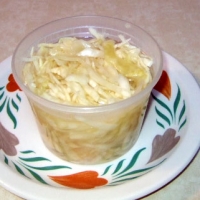Home Made Sauerkraut tutorial
From midgelet 15 years agoIngredients
- You will need a very large crock, glass or enamel container, heavy duty plastic bucket or even wood, all must be totally clean shopping list
- ( put through a dishwasher or clean with the hottest water if you can) shopping list
- Minimum of 2 heads of cabbage ( about a total of 5 lbs ) shopping list
- May be regular or Savoy or 1 part red cabbage to 3 parts green shopping list
- Kosher , or sea salt, or use salt which has no additives, no anti caking, no iodine etc. shopping list
- Not table salt which causes a soft and limp outcome shopping list
- Sometimes pickling or canning salt will change taste and texture too shopping list
- I simply use kosher salt shopping list
- Some tips here to prevent problems ( molds and yeasts ) with your sauerkraut: shopping list
- Never use aluminum utensils! shopping list
- Absolute cleanliness is necessary for a healthy brew! shopping list
- To prepare the cabbage, remove and discard the outer leaves. shopping list
- Wash and drain and then cut the cabbages into halves or quarters while removing the core in the process. shopping list
- Step 1) shopping list
- Shred Cabbage - May use food processor for speed and ease. shopping list
- If you shred by hand, make sure the shreds are no thicker than a nickel or dime! shopping list
- Step 2) shopping list
- Mix, with wooden spoon or very clean hands, 5 pounds of shredded cabbage with 4 tablespoons of kosher salt and toss and mix thoroughly until kosher salt dissolves! shopping list
- (You can make as much as you wish as long as you use the ratio of 5 lbs. cabbage to 4 Tbs. salt.) shopping list
- NOTE: If you plan on refrigerating and not canning ( cooking ) use 3 tbs of salt not 4! shopping list
- Step 3) shopping list
- When juice starts to form on cabbage from tossing - Pack the cabbage firmly and evenly into a clean crock, glass or enamel container. shopping list
- Press firmly to encourage juice formation. shopping list
- Fill the utensil no closer than 5 inches from the top. shopping list
- Step 4) shopping list
- Make sure juice covers the cabbage completely! (This does not always happen unless the cabbage is fresh from the garden) shopping list
- May need to prepare additional brine by putting 1 1/2 Tablespoons of kosher salt into 1 quart of boiling water. shopping list
- Dissolve salt and cool brine to room temperature before adding to the pot of cabbage. shopping list
- Step 5) shopping list
- Once cabbage is immersed in brine water, place a large food grade, plastic bag filled with brine water and lay on top if cabbage... shopping list
- (I use 2 large bags, one inside the other - sometimes a 2 gal freezer bag - with a couple of quarts of cooled brine water inside - this if the bag breaks it will not water down the cabbage into a tasteless mess) shopping list
- The cabbage must be well sealed all around with the bag, so no air can get in and contaminate the sauerkraut with unwanted yeasts or molds! shopping list
- Step 6) shopping list
- Now cover the container with plastic wrap, then a heavy towel or cloth and tie securely into place. shopping list
- Do not remove this until fermenting is complete! shopping list
- Step 7) shopping list
- Put in an area where the temperature will not be above 75 degrees. Fermentation will begin within a day, depending upon the room temperature. shopping list
- Step 8) shopping list
- If room temperature is 75 degrees allow 3 weeks for fermentation. shopping list
- If temperature is 70 degrees allow 4 weeks. shopping list
- If temperature is 65 degrees allow 5 weeks. shopping list
- If temperature is 60 degrees allow 6 weeks. shopping list
- NOTE: If temperature is above 75 or 76 degrees, the sauerkraut may not ferment and could spoil! shopping list
- Step 9) shopping list
- Once fermented taste to see if your required tartness exists. shopping list
- Tartness will weaken as you process in canning ( cooking ) so make sure it is a wee bit more tart than you like! shopping list
- Can be eaten immediately if you desire! shopping list
How to make it
- (I sometimes mix in 1/2 teaspoon caraway seed into 4 cups, enough for a couple of pints or 1 quart.
- This makes a tasty variation. as is a bay leaf also and some people add a bit of white wine for wine kraut
- NOTE: if you refrigerate only rinse and toss with cold water to attain the tartness desired!
- ADDITIONAL NOTES: a neat gift: add a clean fresh brussel sprout in the middle of the kraut in the container!
- Molds and yeasts: unclean vegetables, utensils, too hot conditions etc.are all causes
- If you find mold on top of the kraut , use a muslin cloth and place over the molds in the brine, and let the cloth soak up the molds etc.
- Make sure the cloth is scalded and cleaned before each use
- May repeat as needed to remove all mold.
- Cooking may kill all the molds and yeasts and soften the kraut
- More on fermentation of cabbage:
- From UW's - Bacteriology/Food Science Department - The Sauerkraut Fermentation
- "The salting of the cabbage serves two major purposes.
- First, it causes an osmotic imbalance which results in the release of water and nutrients from the cabbage leaves.
- The fluid expelled is an excellent growth medium for the microorganisms involved in the fermentation.
- It is rich in sugar and growth factors.
- Second, the salt concentration used inhibits the growth of many spoilage organisms and pathogens.
- It does not, obviously, inhibit the desired floral succession.
- As cabbage is approximately 90% water and the salt is dissolved entirely in the water, the actual salt concentration (brine strength) experienced by the microorganisms in their aquatic milieu is around 2.8%.
- Thorough and even distribution of the salt is critical.
- Pockets of low or high salt concentration would result in spoilage and/or lack of the desired fermentation.
- Throughout the fermentation, it is critical that oxygen be excluded.
- The presence of oxygen would permit the growth of some spoilage organisms, particularly the acid-loving molds and yeasts.
- As no starter cultures are added to the system, this is referred to as a wild fermentation.
- The normal flora of the cabbage leaves is relied upon to include the organisms responsible for a desirable fermentation, one that will enhance preservation and organoleptic acceptability.
- The floral succession is governed mainly by the pH of the growth medium.
- Initially, a coliform starts the fermentation.
- Coliforms which have contributed to our lab-made sauerkraut in recent years have included Klebsiella pneumoniae, K. oxytoca and Enterobacter cloacae.
- As acid is produced, an environment more favorable forLeuconostoc is quickly formed.
- The coliform population declines as the population of a strain of Leuconostoc builds.
- As Leuconostoc is a heterofermentative lactic acid bacterium, much gas (carbon dioxide) accompanies the acid production during this stage.
- The pH continues to drop, and a strain of Lactobacillus succeeds the Leuconostoc. (
- On occasion a strain of Pediococcusarises instead of Lactobacillus.)
- The complete fermentation, then, involves a succession of three major groups or genera of bacteria, a succession governed by the decreasing pH."
- Even more on Sauerkraut and Lacto-fermentation
- "No special culture of lactic acid bacteria is needed because these bacteria already are present on raw cabbage.
- Yeasts also are present, and may yield soft sauerkraut of poor flavor when the fermentation temperature is too high.
- The fermentation process has three phases.
- In the first phase, anaerobic bacteria such as Klebsiella and Enterobacter lead the fermentation, and begin producing an acid environment that favours later bacteria.
- The second phase starts as the acid levels become too high for many bacteria, and Leuconostoc mesenteroides and other Leuconostoc spp. take dominance.
- In the third phase, various Lactobacillus species including L. brevis and L. plantarum ferment any remaining sugars, further lowering the pH."
The Rating
Reviewed by 5 people-
Excellent directions! My grandfather and father used to make it. I put it (chopped) in my rye and pumpernickle bread.....mmmm! Thanks for taking the time for this wonderful post!
 dollhead
in Mechanicville loved it
dollhead
in Mechanicville loved it
-
I have to thank you for the time and effort, explanation of the many recipes you post.Wished you could get top honors for this and many others you post with such detail!!
chichimonkeyface in Albany loved it
-
Thank you for this - my grandmother knows how to make it but her process is bigger and this is more simpler for me.
 aussie_meat_pie
in My Kitchen loved it
aussie_meat_pie
in My Kitchen loved it
The Groups
-
I Like Food
84 members -

Food Styling And Photography
254 members -

Tips And Advice
497 members -

Vegetarian Food Lover
425 members -
Low Carb
114 members -

Garden Harvest
90 members -

Anything Goes
294 members -

Low Fat And Fabulous
112 members -

Good For Your Soul Food
32 members -

Dont Knock It Till You Try It
74 members




Reviews & Comments 9
-
All Comments
-
Your Comments
" It was excellent "
" It was excellent "
" It was excellent "